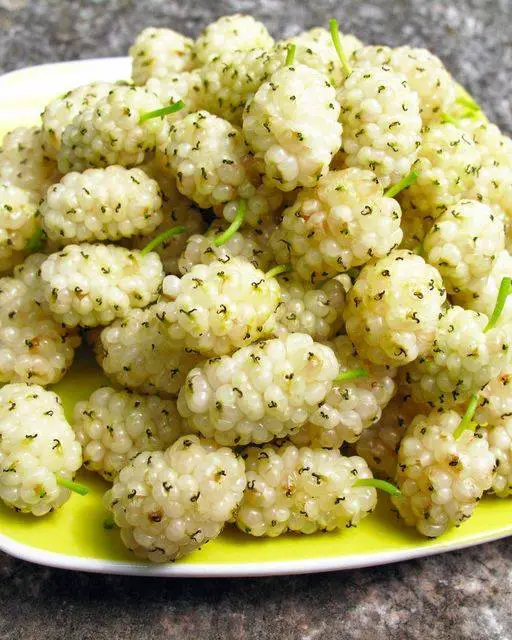Originally from the Far East and once used mainly for silkworm breeding, the white mulberry is finally taking revenge: almost forgotten, it is now valued again not only for its characteristic, sweet and pleasantly sour taste, but above all for its countless beneficial effects Characteristics. Let’s see together what they are and how you can use them in the kitchen (and not only).
The white mulberry plant, which has been widespread in China and Korea for centuries, belongs to the Moraceae family and the Morus genus. It was once used to breed silkworms (mulberry caterpillars) and has now been rediscovered due to its countless benefits and beneficial properties. In fact, of this plant not only the fruits can be used – for natural enjoyment or to make excellent jams, granitas and juices – but also the leaves, which, after drying, are used to prepare infusions, etc. decoctions.
The white mulberry was probably introduced to the Mediterranean in the 12th century and has found an ideal habitat in Italy and southern Europe. The plant can be grown as a shrub, a stump or a tall trunk and the economic lifespan of the mulberry grove varies depending on the climate, soil, form and methods used: for bush mulberry groves it is about 15 years, for those with a tall trunk it can be 60-100 years to become old. The fruit wrongly called the mulberry is a fruit cluster consisting of the true fruit, the nucula, and the false fruit, or pulp. The correct name for this fruit cluster is sorio – botanically speaking, a “false fruit” like the fig – and resembles a blackberry, slightly larger and elongated in shape. It reaches full maturity between July and September.
White turnip: what it is, what benefits it has and how to use it in the kitchen
The fruit is white, tends to be yellowish or purplish-pink – which is why it is sometimes confused with the black mulberry – and is characterized by a sweet, pleasantly sour flesh with a light vanilla aroma. It can be enjoyed on its own or use its sugary taste to make homemade jams, syrups, liqueurs or irresistible desserts. And that’s not all: the limited calorie intake, coupled with a high content of vitamins, mineral salts and antioxidants, makes mulberry a true elixir for a long life. Let’s take a closer look at why.
Properties and benefits of white mulberries
White mulberries are characterized by a limited calorie intake (about 43 calories per 100 grams of product) and an excellent content of natural sugars, fiber and mineral salts. Iron, potassium, manganese and magnesium stand out among them; Among the vitamins, the amount of vitamin C (about 36.4 mg), vitamin K and those of group B is important. It contains valuable substances such as anthocyanins, flavonoids and resveratrol – the latter especially in the black variety – which, has a strong antioxidant power, counteract the effects of free radicals and protect the health of cells, tissues and therefore the entire organism; These substances also play an important role in cardiovascular protection.
Thanks to the richness of water and plant fiber, white mulberry has excellent laxative, cleansing and antibacterial properties.
It also has anti-inflammatory, blood sugar-lowering effects – which is why it is preferable to other fruits in diabetes – antianemic and expectorant. The fruits can also be dried: rich in natural sugars (mainly glucose and fructose) and an excellent source of energy, it is perfect as a snack, pure or mixed with natural yogurt, for those preparing for intense physical activity; It can also be taken after exercise to replenish glycogen and restore normal muscle function. It also promotes digestive activity and prolongs the feeling of satiety.
None of the white mulberries are thrown away
In addition to the fruit, every part of the mulberry is used: the dried leaves can be used to prepare an infusion with a diuretic effect, useful for keeping blood sugar and cholesterol levels under control; It is enough to infuse a handful of leaves in about half a liter of hot water, filter the drink and drink before meals to enjoy its excellent benefits. After cooling, the infusion can be used to make compresses that are applied to irritated or congested areas. The fruit also makes a syrup that helps relieve gum inflammation and can be used as a mouthwash for toothaches. And again: You can use the roots and bark to prepare a decoction that helps regulate intestinal activity. From the series: You don’t actually throw anything away.
The fruits of the white mulberry are less sweet and juicy than those of the dark variety and are therefore less often used for natural consumption. Delicate, with a slightly sour taste and a slight hint of vanilla, it is more suitable for the preparation of jams, juices, infusions, decoctions, but also irresistible desserts, such as the famous and inimitable Sicilian granita, which accompanies the classic brioche with tuppo and a dollop whipped cream. The fruits can also be eaten dried: with a pleasantly sugary-sweet taste, it can be enjoyed on its own as a snack or added to yoghurt, vegetable drinks or porridge for a healthy and delicious breakfast. The bark and leaves are also used to obtain active ingredients from which dietary supplements with excellent beneficial properties are made.


